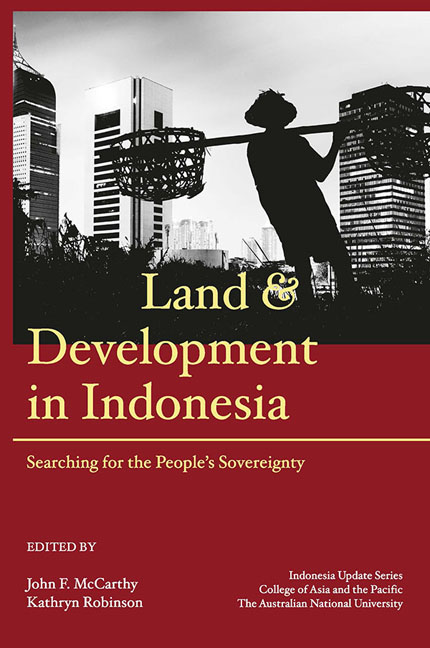Book contents
- Frontmatter
- Contents
- Tables
- Figures
- Contributors
- Acknowledgements
- Glossary
- Map
- 1 Land, economic development, social justice and environmental management in Indonesia: the search for the people's sovereignty
- PART 1 LAND USE AND LAND LAW: THE BIG PICTURE
- PART 2 ENVIRONMENTAL AND CUSTOMARY FRAMING OF LAND TENURE
- PART 3 URBAN AND INFRASTRUCTURE DEVELOPMENT
- 7 Eminent domain and infrastructure under the Yudhoyono and Widodo administrations
- 8 Housing low- and middle-income households: land development and policy practice in two Indonesian cities
- 9 Land and housing security for the urban poor
- PART 4 AGRICULTURE, LAND TENURE AND LIVELIHOODS
- PART 5 LARGE-SCALE LAND ACQUISITIONS AND SMALLHOLDER DEVELOPMENT
- Index
- Miscellaneous Endmatter
8 - Housing low- and middle-income households: land development and policy practice in two Indonesian cities
from PART 3 - URBAN AND INFRASTRUCTURE DEVELOPMENT
Published online by Cambridge University Press: 29 July 2017
- Frontmatter
- Contents
- Tables
- Figures
- Contributors
- Acknowledgements
- Glossary
- Map
- 1 Land, economic development, social justice and environmental management in Indonesia: the search for the people's sovereignty
- PART 1 LAND USE AND LAND LAW: THE BIG PICTURE
- PART 2 ENVIRONMENTAL AND CUSTOMARY FRAMING OF LAND TENURE
- PART 3 URBAN AND INFRASTRUCTURE DEVELOPMENT
- 7 Eminent domain and infrastructure under the Yudhoyono and Widodo administrations
- 8 Housing low- and middle-income households: land development and policy practice in two Indonesian cities
- 9 Land and housing security for the urban poor
- PART 4 AGRICULTURE, LAND TENURE AND LIVELIHOODS
- PART 5 LARGE-SCALE LAND ACQUISITIONS AND SMALLHOLDER DEVELOPMENT
- Index
- Miscellaneous Endmatter
Summary
To respond to the rapid increase in urbanisation across the country, Indonesia needs to develop an effective land policy that facilitates formal housing development and gives all sectors of the population access to good-quality, affordable housing. The share of the urban population reached 30 per cent in 1990, 42 per cent in 2000 and 49.8 per cent when the latest census was conducted in 2010. By 2035, it is expected to reach 66.6 per cent, and to exceed 80 per cent in four provinces in Java: Jakarta, West Java, Yogyakarta and Banten (Bappenas 2013a).
Indonesia's rapid urban growth has increased the numbers of low- and middle-income people residing in the cities and suburbs, but the availability of housing for those people has not kept up with demand. According to data released by the National Development Planning Agency, the housing backlog reached 12 million units in 2013 and is continuing to increase (Bappenas 2013b). Most houses built over the past decade have been built by owner-occupiers (rather than the government or private developers), but many of them are substandard. In 2012, 4 million Indonesians lived in very poor quality dwellings, some of which were not permanent structures, and another 13 million were homeless. While the number of houses constructed each year has increased, many of those dwellings remain unsold due to the high asking prices.
For the most part, owner-occupiers in Indonesia acquire their houses through informal, incremental processes, after squatting on the land, or using an inheritance or loan from a family member to purchase land. These arrangements have become a quick and ready solution to address the housing backlog. However, informal processes are considered inefficient in providing low- and middle-income people with adequate access to urban amenities and infrastructure such as water, sewage, electricity or even the postal system (Monkonnen 2013: 257).
Meanwhile, economic growth has been pushing up land prices, squeezing low- and middle-income Indonesians out of the market. Unable to access well-located land, the poor are forced to squat on land that may be hazardous, without proper services and amenities, or located far from the city centre, without any assistance in terms of planning or provision of basic services, or even official recognition of their existence. Illegal occupation of land, in its various forms, often triggers land-use conflicts and makes it difficult for government to build infrastructure and facilities.
- Type
- Chapter
- Information
- Land and Development in IndonesiaSearching for the People's Sovereignty, pp. 186 - 205Publisher: ISEAS–Yusof Ishak InstitutePrint publication year: 2016

